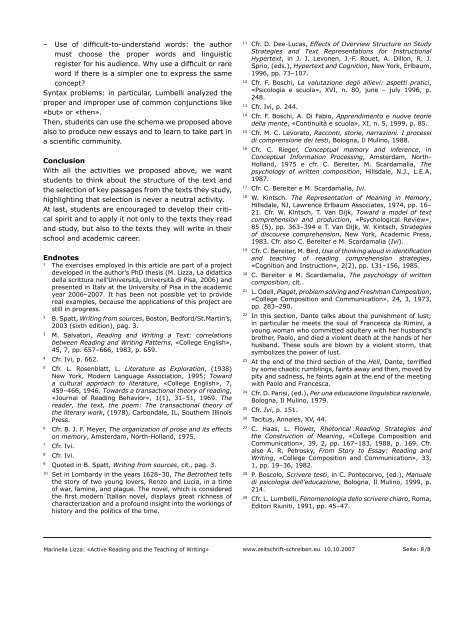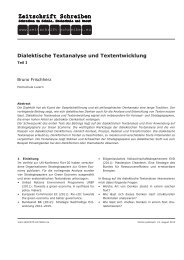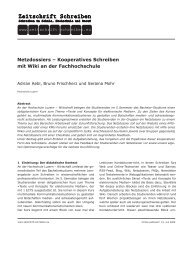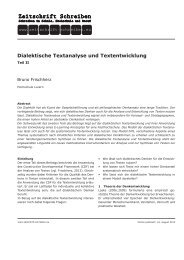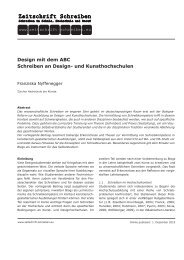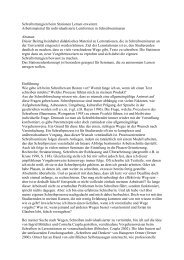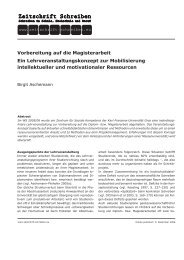Active Reading and the Teaching of Writing - Zeitschrift Schreiben
Active Reading and the Teaching of Writing - Zeitschrift Schreiben
Active Reading and the Teaching of Writing - Zeitschrift Schreiben
Create successful ePaper yourself
Turn your PDF publications into a flip-book with our unique Google optimized e-Paper software.
– Use <strong>of</strong> difficult-to-underst<strong>and</strong> words: <strong>the</strong> author<br />
must choose <strong>the</strong> proper words <strong>and</strong> linguistic<br />
register for his audience. Why use a difficult or rare<br />
word if <strong>the</strong>re is a simpler one to express <strong>the</strong> same<br />
concept?<br />
Syntax problems: in particular, Lumbelli analyzed <strong>the</strong><br />
proper <strong>and</strong> improper use <strong>of</strong> common conjunctions like<br />
«but» or «<strong>the</strong>n».<br />
Then, students can use <strong>the</strong> schema we proposed above<br />
also to produce new essays <strong>and</strong> to learn to take part in<br />
a scientific community.<br />
Conclusion<br />
With all <strong>the</strong> activities we proposed above, we want<br />
students to think about <strong>the</strong> structure <strong>of</strong> <strong>the</strong> text <strong>and</strong><br />
<strong>the</strong> selection <strong>of</strong> key passages from <strong>the</strong> texts <strong>the</strong>y study,<br />
highlighting that selection is never a neutral activity.<br />
At last, students are encouraged to develop <strong>the</strong>ir critical<br />
spirit <strong>and</strong> to apply it not only to <strong>the</strong> texts <strong>the</strong>y read<br />
<strong>and</strong> study, but also to <strong>the</strong> texts <strong>the</strong>y will write in <strong>the</strong>ir<br />
school <strong>and</strong> academic career.<br />
Endnotes<br />
1<br />
The exercises employed in this article are part <strong>of</strong> a project<br />
developed in <strong>the</strong> author’s PhD <strong>the</strong>sis (M. Lizza, La didattica<br />
della scrittura nell’Università, Università di Pisa, 2006) <strong>and</strong><br />
presented in Italy at <strong>the</strong> University <strong>of</strong> Pisa in <strong>the</strong> academic<br />
year 2006–2007. It has been not possible yet to provide<br />
real examples, because <strong>the</strong> applications <strong>of</strong> this project are<br />
still in progress.<br />
2<br />
B. Spatt, <strong>Writing</strong> from sources, Boston, Bedford/St.Martin’s,<br />
2003 (sixth edition), pag. 3.<br />
3<br />
M. Salvatori, <strong>Reading</strong> <strong>and</strong> <strong>Writing</strong> a Text: correlations<br />
between <strong>Reading</strong> <strong>and</strong> <strong>Writing</strong> Patterns, «College English»,<br />
45, 7, pp. 657–666, 1983, p. 659.<br />
4<br />
Cfr. Ivi, p. 662.<br />
5<br />
Cfr. L. Rosenblatt, L. Literature as Exploration, (1938)<br />
New York, Modern Language Association, 1995; Toward<br />
a cultural approach to literature, «College English», 7,<br />
459–466, 1946. Towards a transactional <strong>the</strong>ory <strong>of</strong> reading,<br />
«Journal <strong>of</strong> <strong>Reading</strong> Behavior», 1(1), 31–51, 1969. The<br />
reader, <strong>the</strong> text, <strong>the</strong> poem: The transactional <strong>the</strong>ory <strong>of</strong><br />
<strong>the</strong> literary work, (1978), Carbondale, IL, Sou<strong>the</strong>rn Illinois<br />
Press.<br />
6<br />
Cfr. B. J. F. Meyer, The organization <strong>of</strong> prose <strong>and</strong> its effects<br />
on memory, Amsterdam, North-Holl<strong>and</strong>, 1975.<br />
7<br />
Cfr. Ivi.<br />
8<br />
Cfr. Ivi.<br />
9<br />
Quoted in B. Spatt, <strong>Writing</strong> from sources, cit., pag. 3.<br />
10<br />
Set in Lombardy in <strong>the</strong> years 1628–30, The Betro<strong>the</strong>d tells<br />
<strong>the</strong> story <strong>of</strong> two young lovers, Renzo <strong>and</strong> Lucia, in a time<br />
<strong>of</strong> war, famine, <strong>and</strong> plague. The novel, which is considered<br />
<strong>the</strong> first modern Italian novel, displays great richness <strong>of</strong><br />
characterization <strong>and</strong> a pr<strong>of</strong>ound insight into <strong>the</strong> workings <strong>of</strong><br />
history <strong>and</strong> <strong>the</strong> politics <strong>of</strong> <strong>the</strong> time.<br />
11<br />
Cfr. D. Dee-Lucas, Effects <strong>of</strong> Overview Structure on Study<br />
Strategies <strong>and</strong> Text Representations for Instructional<br />
Hypertext, in J. J. Levonen, J.-F. Rouet, A. Dillon, R. J.<br />
Sprio, (eds.), Hypertext <strong>and</strong> Cognition, New York, Erlbaum,<br />
1996, pp. 73–107.<br />
12<br />
Cfr. F. Boschi, La valutazione degli allievi: aspetti pratici,<br />
«Psicologia e scuola», XVI, n. 80, june – july 1996, p.<br />
248.<br />
13<br />
Cfr. Ivi, p. 244.<br />
14<br />
Cfr. F. Boschi, A. Di Fabio, Apprendimento e nuove teorie<br />
della mente, «Continuità e scuola», XI, n. 5, 1999, p. 85.<br />
15<br />
Cfr. M. C. Levorato, Racconti, storie, narrazioni. I processi<br />
di comprensione dei testi, Bologna, Il Mulino, 1988.<br />
16<br />
Cfr. C. Rieger, Conceptual memory <strong>and</strong> inference, in<br />
Conceptual Information Processing, Amsterdam, North-<br />
Holl<strong>and</strong>, 1975 e cfr. C. Bereiter, M. Scardamalia, The<br />
psychology <strong>of</strong> written composition, Hillsdale, N.J., L.E.A,<br />
1987.<br />
17<br />
Cfr. C. Bereiter e M. Scardamalia, Ivi.<br />
18<br />
W. Kintsch. The Representation <strong>of</strong> Meaning in Memory,<br />
Hillsdale, NJ, Lawrence Erlbaum Associates, 1974, pp. 16–<br />
21. Cfr. W. Kintsch, T. Van Dijk, Toward a model <strong>of</strong> text<br />
comprehension <strong>and</strong> production, «Psychological Review»,<br />
85 (5), pp. 363–394 e T. Van Dijk, W. Kintsch, Strategies<br />
<strong>of</strong> discourse comprehension, New York, Academic Press,<br />
1983. Cfr. also C. Bereiter e M. Scardamalia (Ivi).<br />
19<br />
Cfr. C. Bereiter, M. Bird, Use <strong>of</strong> thinking aloud in identification<br />
<strong>and</strong> teaching <strong>of</strong> reading comprehension strategies,<br />
«Cognition <strong>and</strong> Instruction», 2(2), pp. 131–156, 1985.<br />
20<br />
C. Bereiter e M. Scardamalia, The psychology <strong>of</strong> written<br />
composition, cit..<br />
21<br />
L. Odell, Piaget, problem solving <strong>and</strong> Freshman Composition,<br />
«College Composition <strong>and</strong> Communication», 24, 3, 1973,<br />
pp. 283–290.<br />
22<br />
In this section, Dante talks about <strong>the</strong> punishment <strong>of</strong> lust;<br />
in particular he meets <strong>the</strong> soul <strong>of</strong> Francesca da Rimini, a<br />
young woman who committed adultery with her husb<strong>and</strong>’s<br />
bro<strong>the</strong>r, Paolo, <strong>and</strong> died a violent death at <strong>the</strong> h<strong>and</strong>s <strong>of</strong> her<br />
husb<strong>and</strong>. These souls are blown by a violent storm, that<br />
symbolizes <strong>the</strong> power <strong>of</strong> lust.<br />
23<br />
At <strong>the</strong> end <strong>of</strong> <strong>the</strong> third section <strong>of</strong> <strong>the</strong> Hell, Dante, terrified<br />
by some chaotic rumblings, faints away <strong>and</strong> <strong>the</strong>n, moved by<br />
pity <strong>and</strong> sadness, he faints again at <strong>the</strong> end <strong>of</strong> <strong>the</strong> meeting<br />
with Paolo <strong>and</strong> Francesca.<br />
24<br />
Cfr. D. Parisi, (ed.), Per una educazione linguistica razionale,<br />
Bologna, Il Mulino, 1979.<br />
25<br />
Cfr. Ivi, p. 151.<br />
26<br />
Tacitus, Annales, XV, 44.<br />
27<br />
C. Haas, L. Flower, Rhetorical <strong>Reading</strong> Strategies <strong>and</strong><br />
<strong>the</strong> Construction <strong>of</strong> Meaning, «College Composition <strong>and</strong><br />
Communication», 39, 2, pp. 167–183, 1988, p. 169. Cfr.<br />
also A. R. Petrosky, From Story to Essay: <strong>Reading</strong> <strong>and</strong><br />
<strong>Writing</strong>, «College Composition <strong>and</strong> Communication», 33,<br />
1, pp. 19–36, 1982.<br />
28<br />
P. Boscolo, Scrivere testi, in C. Pontecorvo, (ed.), Manuale<br />
di psicologia dell’educazione, Bologna, Il Mulino, 1999, p.<br />
214.<br />
29<br />
Cfr. L. Lumbelli, Fenomenologia dello scrivere chiaro, Roma,<br />
Editori Riuniti, 1991, pp. 45–47.<br />
Marinella Lizza: «<strong>Active</strong> <strong>Reading</strong> <strong>and</strong> <strong>the</strong> <strong>Teaching</strong> <strong>of</strong> <strong>Writing</strong>» www.zeitschrift-schreiben.eu 10.10.2007 Seite: /8


